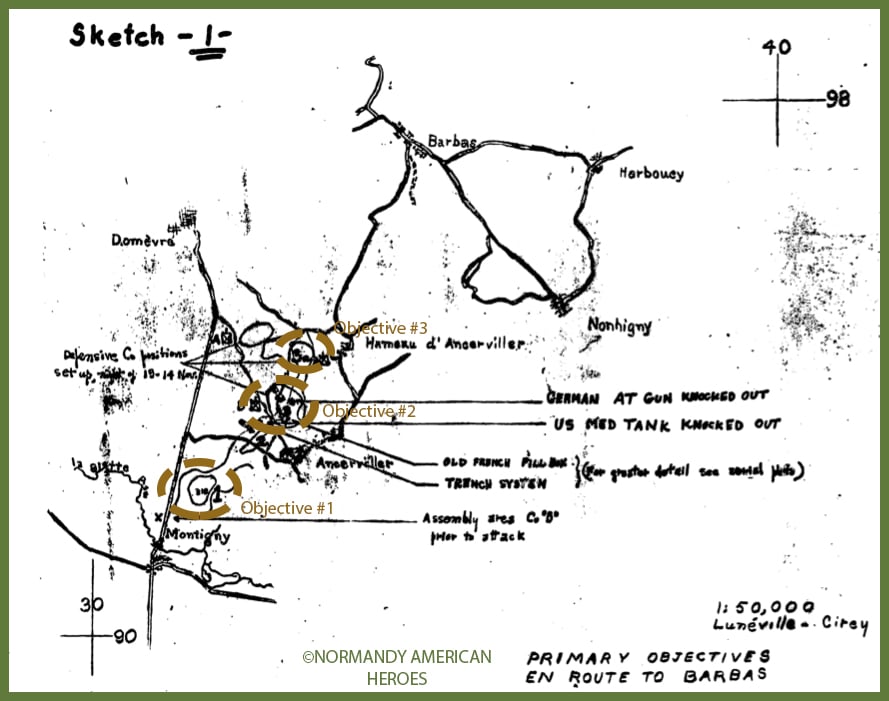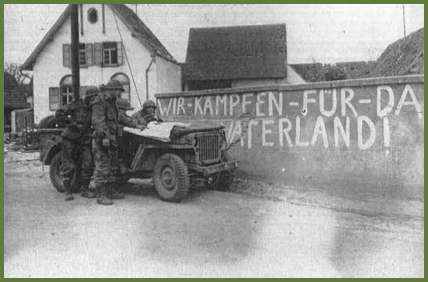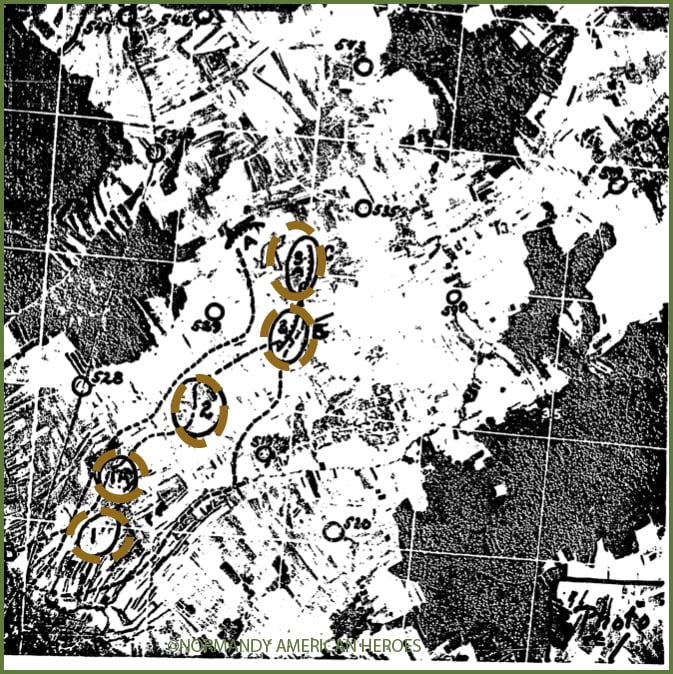August 21st, 1944, after one-hundred days of heavy fighting the Normandy Campaign ends and the Rat Race began. By that time while the German Army was escaping toward the East trying to find shelter behind the border, in Germany, the American Army thought the end of the war would be over very soon. But between France and Germany there is Alsace-Lorraine, the two most popular parts of France.
Since the French-Prussian war in 1870, those two locations were one of the many reasons why France and Germany have been at war in 1914 and 1940.
After the German invasion of France in June 1940, Alsace-Lorraine departments were not annexed by the Nazis like they did with Austria but they became part of the 3rd Reich which means from now on everything would be in German. Names of the streets, villages, even first and last names of the locals.
While the first U.S troops were entering this area of France they were also entering in the Reich.
Jump-off at Montigny
During the first months of battle in France, the Division started the war under the command of the 1st US Army then 3rd and had become on September 29th, an element of the 7th US Army.
After heavily continuous actions against enemy troops from Normandy to the Belgium border then to the Eastern part of France, 79th Infantry Division closed in at Lunéville on October 25th, 1944, at 0430pm, it was time to rest.
In Lunéville men of the Division were able to take time to vote and elect Franklin Roosevelt for a fourth time - ©Footage CombatReels.com
Then in November plans and orders came for an attack to break the German lines. How so?
44th and 79th Infantry Divisions had to use the breakthrough made by 2nd French Armored Division through the enemy lines and to pace them to the Saverne Gap and beyond toward the Rhine valley.
The leading unit of the 79th during this attack was the 314th Infantry Regiment which had as objective the high ground above the village of Montigny in the direction of Barbas. The jump-off was set for November 13th.
Replacements were received while in Lunéville -- ©Footage CombatReels.com
In preparation of this attack toward Montigny, 1st Battalion commanded by Lieutenant-Colonel Olin E. Teague had two days-walk, first one was on November 11th, when it moved out from Lunéville to one of the several assembly areas at the East of the town and the second found the Battalion walking toward Ogéviller. As the 1st Battalion would have to approach Montigny by the South, Lieutenant-Colonel Teague requested that the rest of the walk toward Montigny had to be made at night to use the cover of darkness along a more direct approach from Ogéviller through Réclonville, through Pettonville, toward Vaxainville, then swinging to the main Ogéviller – Montigny Road.
That road of advance was right in the middle of a “no man’s land” and according to Colonel Teague his men would arrive at Montigny in better condition for an attack as Germans will not have the time to see it coming and would be surprised, as the jump-off was scheduled at dawn. Lucky they were as that night from November 12th to the 13th was very dark and between 0200am and 0300am it began to snow.
That long walk during darkness of approximately 7 Miles has been successful and two hours before the jump-off takes place, 1st Battalion came into Montigny with “B” Company leading, then turned to the left at the crossroad and moved across La Blette River bridge before to close in an assembly area on the left side of the road. Captain Elisha Amos gave the order of silence as his men were ready for the assault at 0700am.
In the meantime, while “B” Company was assembling, artillery support as being received from 311th Field Artillery Battalion and Corps Artillery. Three rounds were shot but fell right in the middle of “B” Company positions causing friendly casualties. Four men were wounded in action and one killed. Because of this friendly fire the attack was postponed of fifteen minutes.
“B” Company’s first objective was codenamed Objective #1 Hill 318 located 500 yards to the right of the road.

Somewhat short of a mile and a half from the village along the Montigny – Domèvre-sur-Vezouze road a trail branches off to the right, goes over the slope of a second hill and down into Ancerviller. The second Hill (Objective #3) continues along a ridge line, running generally East to North, through Objectives #3 and #3a, the latter being just West and a little South of Le Hameau d’Ancerviller.
The ridge from Objective #1 through #3a is an elongated, slightly curved S-line in reverse. The hills rise with a wide gradual sweep, brush and occasional tress appear in scattered spots; fields on the Ancerviller slopes are plowed. Small rectangular patches of woods are situated near the top of each of the hills. Visibility from each hilltop is excellent to the point of being amazing.
To the East can be seen the high Vosges, to the West detailed terrain features could be observed on a clear day for several miles in a full arc. The German artillery observers had everything in their favor.
German gunners didn’t open fire until the jump off took place, Montigny became hell and several American vehicles were damaged or destroyed that day. The weather warmed up a bit with the sunrise, snow which was from two to three inches deep on the ground was wet.
Boys of “B” Company in lead were attacking by making a frontal attack up the slope of the first hill while “A” Company was going around the hill on the right flank. This movement was only made possible thanks to the fire support made by “D” Company which was in position at Montigny. All Companies were advancing against machine gun and antitank fire, 2nd Platoon led by 1st Lieutenant William J. Lomac had a very specific first objective which was twin patches of brush just short of the top of the hill. He had to take and to hold it up but his men were pinned down by machine guns protecting the top of Objective #1 killing one man and wounding a few.
(Note: 1st Sergeant Earl E. Goff of the Company was shot twice in the stomach. This attack caused a lot of casualties, 2nd Platoon jumped off with forty-three men, once Objective #1 was finally taken, only eighteen were still able to fight).
Thirty minutes after the jump-off four tanks came in action to assist “B” Company, all together pushed forward past Hill 318. By seeing tanks coming in action the remainders of the German force protecting the hill started to withdraw and at 08:15am, report came into Battalion Command Post stating that Objective #1 had been taken.
This was not the end of the mission for “B” Company because once Hill 318 taken, men were pushing forward Objective #2 by 0900am. Germans were now on alert, effect of surprise was gone. Technical Sergeant Fred Phiester led his 3rd Platoon in the frontal assault, followed by 1st and 2nd Platoons. The only cover available was the cover of the slope provided by the hill itself but men were uncovered as they were receiving fire from Ancerviller.
 We fight for the Fatherland - Somewhere in Lorraine
We fight for the Fatherland - Somewhere in Lorraine
From, the rectangular patch of woods on Objective #3 was coming heavy fire. This is a rather thick woods, mostly spruce, an estimated 20 by 120 yards. Near the southeast corner of the tree line was located a well camouflaged 75mm German antitank gun, covering the second hill and the depression between the two hills which was like the hollow of an almost open hand, a murderous field of fire.
The wood was “packed with Germans”, firing not only the antitank gun but machine guns, small arms, and bazookas. Over the crest of the second hill (Objective #3) and about 250 yards beyond the Ancerviller trail one of the medium US tanks supporting “B” Company was knocked out by direct fire from the antitank gun, the crew escaped. The other three tanks backed down behind the hill.
3rd Platoon was pinned down on Objective #2 and the rest of “B” Company was couple of yards away from it. Ancerviller became the place of increasing enemy fire, Germans were firing on 3rd Platoon with everything they had, small arms fire, antitank weapons, artillery fire wounding Captain Amos who was later evacuated (Lieutenant Lomac assumed the command of the 3rd Platoon) and killing 1st Lieutenant Beard, Executive Officer.
“B” Company went over the hill supported by the three remaining tanks, moving up under the cover of the artillery. The German antitank gun was firing at personnel and at the tanks, it was finally knocked out, apparently by direct fire from one of the tanks, German bazooka fire was still coming in. Lieutenant Lomac and Private First-Class Carl Decker ducked one bazooka round upon the Lieutenant’s warning “Duck, here it comes”.
Tanks breakthrough the barbed wire in front of the trench systems which ran into the woods near the knocked-out antitank gun. After going through hell to seize Objective #2, it was under control by 0200pm. And “B” Company was now engaged to seize Objective #3.

This map was made by the men of the 314th Infantry Regiment shows objectives during the battle for Montigny.
Once again “B” Company was doing the frontal assault while “A” Company was moving on the left and “C” Company on the right around Objective #1, came to the entrance of the German trench system on both sides of the trail not more than 300 yards from the edge of Ancerviller. German trenches were zig-zag covered with spruce bough revetments, enemy was also using First World War pillboxes and bunkers running from villages of Blamont, Richeval and beyond.
Those trenches have been dug in by civilians every 50 to 100 yards but only a small number were protected by guns and gunners. According to “C” Company’s Officers they ran into much greater difficulty and had to use enemy trenches to cover their progression all the way to Objective #3.
“B” Company finished to clean up Objective #3 and dug in for the night. “C” Company went to the pursue of the Germans retreating from Objective #3 while “A” Company went to a patch of woods on the left flank North and West and not more than 500 yards away from Objective #3 to keep contact with the rest of the Battalion.
At 0500pm the report saying that the three objectives were taken was received at the Command Post. B” Company which had fought the main assault under fire for almost ten hours, sustained the heaviest losses in the Battalion, six KIA, fifty-six WIA. Some men received minor wounds which were not reported. It had lost both, Company Commander and Executive Officer as well as key non-commissioned personnel.
- “A” Company had one man WIA.
- “C” Company had eight men WIA.
- Battalion Headquarters, which was set up in Montigny at 1030 hours on the 13th of November, counted two men WIA.
- “D” Company, which had played a supporting role by delivering mortar and machine gun fire suffered one man KIA, and four men WIA.
On the 14th of November, the entire Battalion moved forward into new positions, “C” Company in the front was in a wood called Noir Bois and Clair Bois, halfway between Le Hameau D’Ancerviller and Barbas.
“B” Company dug in at Le Hameau D’Ancerviller and “A” Company took position to the right of the road between “C” and “B” Company while “D” moved into an area West of the Ancerviller-Barbas Road.
It was now time to fight for the village of Barbas.
Written by Pierre Fallet - Normandy American Heroes

















